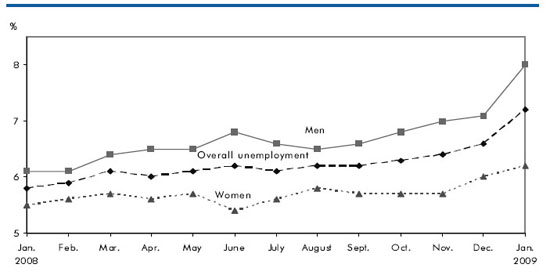Quick fact
Archived Content
Information identified as archived is provided for reference, research or recordkeeping purposes. It is not subject to the Government of Canada Web Standards and has not been altered or updated since it was archived. Please "contact us" to request a format other than those available.
Men's unemployment
Men's unemployment rate shot up 0.9 percentage points to 8.0% in January 2009, compared with a 0.2 point increase for women, to 6.2%. The large increase for men contributed to pushing the overall unemployment rate to 7.2% in January from 6.6% in the previous month.
This increase in overall unemployment was the result of employment losses totalling 129,000 among workers age 15 years and plus. While men's share in the workforce was 52%, they accounted for nearly three-quarters (72%) of the employment decline.
Unemployment rate for men and women

Source: Statistics Canada, Labour Force Survey, seasonally adjusted data.
Among workers age 25 to 54 (the core age group), employment fell by 111,000 from December 2008 to January 2009, with men accounting for nearly two-thirds of the decline.
Over the 12 months from January 2008 to January 2009, the decline in employment occurred in many industries with a high concentration of male workers (around three-quarters of the workforce), such as manufacturing, utilities, transportation and warehousing, and agriculture.
By contrast, many industries with a large concentration of women saw some employment growth—for example, health care and social assistance (5.1%), accommodation and food services (2.9%), other services (2.1%), and finance, insurance, real estate and leasing (1.6%). Women's share in these industries ranges from 55% in other services to 82% in health. The only exception was education, where women make up 66% of the workforce, with an employment decline of 1.5%.
- Date modified:
